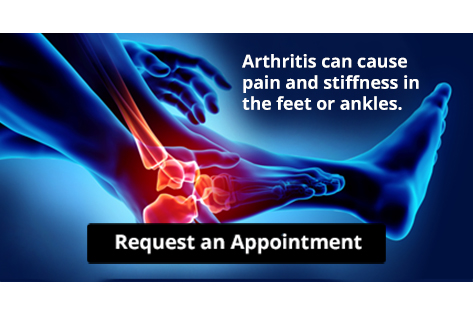October 2024
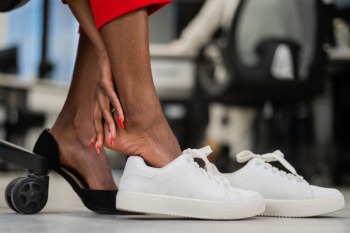
Heel pain is a common issue that can affect daily activities like walking or standing. One of the most frequent causes is plantar fasciitis, which occurs when the tissue connecting your heel to your toes becomes inflamed. Other causes include heel spurs, Achilles tendonitis, or overuse from activities like running or prolonged standing. To find relief, start by resting your feet and avoiding activities that worsen the pain. Wearing supportive shoes can also relieve tension in the heel. If pain persists, it is suggested that you consult a chiropodist who may recommend targeted stretches and exercises or custom orthotics, in addition to monitoring your foot health.
Heel pain is a common problem that can be caused by a variety of injuries, medical conditions, and other factors. If you suffer from heel pain, please consult with one of the chiropodists from The Footcare Centre. Our chiropodists can help you maintain the health of your lower limbs and your mobility.
When it comes to heel pain, the exact location and type of pain are important to note. Some of the conditions that may cause heel pain include:
Plantar fasciitis - An inflammation of the ligament that runs along the bottom of the foot; it causes a stabbing pain under the heel that is at its worst when taking your first few steps after a long rest and while standing on your tiptoes or climbing stairs
Achilles tendonitis - An inflammation of the tendon in the back of the calf; it causes pain in the back of the heel that is at its worst after resting, as well as ankle and calf stiffness, swelling, and tenderness
Bone spurs - Bony lumps on the back of the heel bones that cause sharp pain upon first standing up; the pain becomes dull and achy over time
Heel fractures - A break or crack in the heel bone that causes pain, swelling, and difficulty walking
Retrocalcaneal bursitis - Swelling of the small, fluid-filled sac at the back of the heel bone; it causes pain, swelling, redness, and warmth in the back of the heel
Tarsal tunnel syndrome - Compression of the posterior tibial nerve which causes a pins and needles sensation in the heel, foot, and calf
Your chiropodist will be able to diagnose the underlying cause of your pain and prescribe the right treatments for you. If you have any questions, please feel free to contact our office located in . We offer the newest diagnostic and treatment technologies for all your foot care needs.
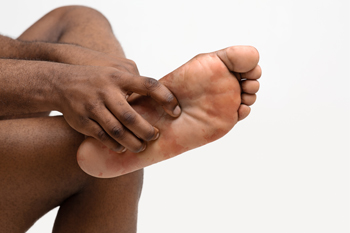
Foot rashes can arise from various conditions, each presenting unique challenges and discomfort. One prevalent cause is athlete's foot, a fungal infection that leads to red, itchy, and flaky skin, often between the toes. Another common culprit is contact dermatitis, which occurs when the skin reacts to irritants or allergens, resulting in redness, swelling, and itching. Exposure to plants such as poison oak, ivy, or sumac can also cause rashes on the feet and ankles, as these plants contain oils that trigger allergic reactions upon contact. Symptoms may include blisters, peeling skin, and intense itching. Identifying the cause of a foot rash is essential for effective treatment and prevention. If you have developed a foot rash, it is suggested that you consult a chiropodist who can offer you effective relief and treatment solutions.
Foot pain is a common problem treated by chiropodists. If you have foot pain, please consult with one of the chiropodists from The Footcare Centre. Our chiropodists can help you maintain the health of your lower limbs and your mobility.
When you are experiencing foot pain, it’s important to note the type of pain and its location, as this can help determine a diagnosis.
Pain in the top of the foot may be caused by:
Stress fractures
Sinus tarsi syndrome
Extensor tendonitis
Tibialis anterior tendonitis
Gout
Athlete’s foot
Ganglion cysts
Pain in the bottom of the foot may be caused by:
Plantar fasciitis
Foot cramps
Tarsal tunnel syndrome
Plantar fibromatosis
Posterior tibial tendonitis
Stress fractures
Flat feet
Pain on the side of the foot may be caused by:
Ankle sprain
Cuboid syndrome
Peroneal tendonitis
Stress fractures
Bunions
Corns or calluses
Posterior tibial tendonitis
Heel pain may be caused by:
Plantar fasciitis
Achilles tendonitis
Bone spurs
Heel fractures
Retrocalcaneal bursitis
Sever’s disease
Pain in the toes may be caused by:
Gout
Hammertoe
Turf toe
Bunions
Ingrown toenails
Blisters
Arthritis
These and many more conditions can be treated by a chiropodist. If you have any questions, please feel free to contact our office located in . We offer the newest diagnostic and treatment technologies for all your foot care needs.
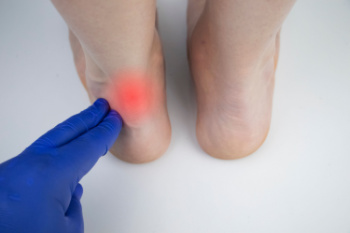
Diagnosing Achilles tendon injuries is essential for effective treatment and recovery. Common symptoms include pain along the back of the heel, swelling, and stiffness, particularly in the morning. A chiropodist will begin with a physical examination to assess tenderness and range of motion. One vital diagnostic tool is the Achilles tendon rupture test, known as the Thompson test. During this test, the patient lies face down while the examiner squeezes the calf muscle. If the foot does not move, it may indicate a rupture of the Achilles tendon. Additional imaging tests like ultrasounds or MRI scans can provide further clarity on the extent of the injury. If you have pain in the lower part of your calf, it is suggested that you schedule an appointment with a chiropodist who can perform the correct diagnostic test for an Achilles tendon injury.
Achilles tendonitis is a common injury of the Achilles tendon, a band of fibrous tissue that runs along the back of the lower leg. The Achilles tendon can also rupture, making it impossible to lift the foot. If you are suffering from heel or calf pain, please consult with one of the chiropodists from The Footcare Centre. Our chiropodists can help you maintain the health of your lower limbs and your mobility.
Causes of Achilles tendon injuries include:
Repetitive stress or overuse
Sudden increase in activity levels
High impact injury
Calf muscle tightness or weakness
Altered foot biomechanics
Heel bone spurs
Underlying medical conditions that weaken the tendon
Symptoms of an Achilles tendon injury include:
Heel and calf pain that worsens following exercise
Chronic heel and calf pain
Sudden pain in the back of the ankle or calf
A popping or snapping sensation
Thickened lump in the Achilles tendon
Ankle and calf stiffness
Decreased range of motion in the affected foot
Swelling
Difficulty walking
Treatment
Resting the affected leg
Applying ice
Compressing the foot and ankle
Elevating the injured leg
Wearing orthotics
Low impact exercises
Stretches
Strengthening exercises
Non-steroidal anti-inflammatory medications
Cortisone injections
Surgery, if the tendon is ruptured
Achilles tendon injuries can be very painful and lead to reduced mobility if left untreated. If you have any questions, please feel free to contact our office located in . We offer the newest diagnostic and treatment technologies for all your foot care needs.
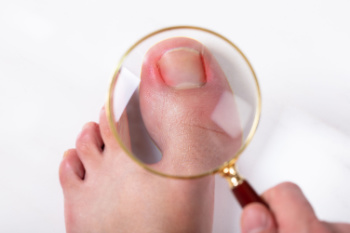
An ingrown toenail occurs when the edge of a toenail grows into the surrounding skin, causing discomfort and potential infection. Common symptoms include redness, swelling, and pain around the affected toe, which can worsen if left untreated. The primary causes of ingrown toenails often involve improper nail trimming, wearing tight or ill-fitting shoes, and injury to the toe. Risk factors that increase the likelihood of developing an ingrown toenail include having naturally curved toenails, engaging in activities that put pressure on the toes, and a genetic predisposition. An ingrown toenail can cause severe pain and discomfort. If you notice signs you have developed this condition, it is strongly suggested that you promptly schedule an appointment with a chiropodist who can effectively treat ingrown toenails.
Ingrown toenails may require medical attention. If you have significant pain or notice signs of infection from an ingrown toenail, please consult with one of the chiropodists from The Footcare Centre. Our chiropodists will assess your condition and provide you with quality foot and ankle treatment.
What Is an Ingrown Toenail?
An ingrown toenail occurs when the edges of a toenail grow into the surrounding skin. The toenails of the big toe are usually affected, however, an ingrown toenail can happen on any toe. Sometimes, the area can become infected leading to potentially serious complications. The ingrown toenail may be caused by improper trimming of the toenail, wearing ill-fitting shoes, or injury to the nail.
Symptoms
The symptoms of an ingrown toenail include:
Pain
Swelling
Redness
Warmth
Pus or drainage from the affected nail or a fever may indicate an infection of the area.
Treatment
Treatment depends on the severity of the ingrown toenail. In less severe cases, home treatment may be adequate. Soaking the affected foot in warm water and gently lifting the nail from the skin with a piece of clean cotton can help. In more severe cases, you may need to use topical or oral antibiotics to treat an infection. Surgical removal of the ingrown toenail may be required if more conservative treatments fail.
Ingrown toenails may be prevented by wearing well-fitted shoes and properly trimming the toenails. Toenails should be trimmed straight across and not too short when using nail clippers.
If you have any questions, please feel free to contact our office located in . We offer the newest diagnostic and treatment technologies for all your foot care needs.
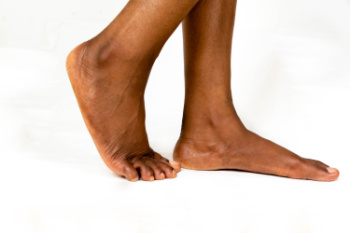
Flat feet, or fallen arches, can affect adults due to various underlying conditions. Obesity is a significant factor, as excess body weight places additional stress on the feet, potentially leading to flattening of the arches over time. High blood pressure can also contribute, as it may affect the blood flow and health of connective tissue in the feet. Diabetes is another risk factor, as it can cause nerve damage and poor circulation, impacting foot structure. Rheumatoid arthritis, an autoimmune disorder, can lead to joint inflammation and deformities, including flat feet. Symptoms often include foot pain, swelling, and a noticeable change in foot shape. If you have flat feet, it is suggested that you visit a chiropodist who can check your foot health and help you to monitor this condition.
Flat feet are a common foot condition. If you are experiencing pain or discomfort due to flat feet, please consult with one of the chiropodists from The Footcare Centre. Our chiropodists will assess your condition and provide you with quality foot and ankle treatment.
What Are Flat Feet?
Flat feet are feet that do not have a well-defined arch in the middle of the sole of the foot. Flat feet may be flexible or rigid. Flexible flat feet have an arch when there is no pressure put on the foot, such as when one is sitting, but the arch disappears upon standing. Rigid flat feet lack an arch regardless of whether one is standing or not.
Causes
Flat feet can be present from birth or acquired over time due to a weakening of the ligaments in the arch. Sometimes flat feet are caused by illnesses, injuries, or pregnancy.
Symptoms
Flat feet often cause no noticeable symptoms. However, some people may experience pain and discomfort due to their flat feet.
Symptoms associated with flat feet include:
Pain in the arch, heel, ankle, or along the outside of the foot
Overpronation of the foot
Shin splints
Aching or fatigue in the feet or legs
Pain in the knees, hips, or lower back
Treatment
In cases where flat feet cause symptoms, there are various treatments available. Wearing orthotic inserts in your shoes to provide more arch support, performing stretches, and taking medications may improve your symptoms. If you are overweight, losing weight can help relieve pressure on the feet. In severe cases, surgery may be considered.
If you have any questions, please feel free to contact our office located in . We offer the newest diagnostic and treatment technologies for all your foot care needs.
Blog Archives
- 2025
- 2024
- 2023
- 2022
- 2021
- 2020
